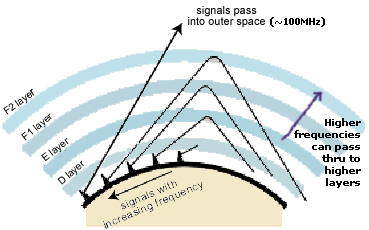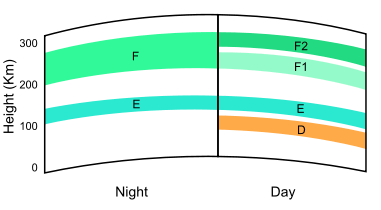As we learned in an earlier post on the ionosphere, the real magic in ham radio is skywave propagation where HF band (and sometimes VHF) signals can travel well beyond line of sight (over the horizon), even to the other side of the planet if conditions are right and radio waves may bend back to earth in the ionosphere.
The sun is largely responsible for energizing the ionosphere and affecting its quality (height, density, thickness, disturbance). Unfortunately for hams, solar activity is highly variable, not constant. There are periods of excellent skywave propagation when the sun is busy and then times of poor propagation when the sun is quiet.

This topic is very complex and not completely understood. Study is ongoing and radio amateurs have contributed greatly to the science; much has been learned in the last 100 years or so since radio became a real thing. Great detail is found below in some excellent web links. A brief summary of how solar activity influences the ionosphere is presented here:
- Our sun tends to be active in 11 year cycles, on average

- Sunspot counts are a general indicator of solar activity
- Propagation on higher frequencies is more influenced by solar activity than the lower frequency bands.
- Ionospheric condition is influenced by the Earth’s magnetic flux lines.
- Earth’s magnetic field is strongly influenced by solar wind (largely a day/night phenomenon but solar wind can spike with disturbances).
- Solar flares, coronal mass ejections (CME), and coronal holes cause geomagnetic storms which affect or disrupt radio communication and create noise.
Solar/Space weather is a study of how solar events affect the earth’s magnetosphere. A/K (long/short-term) indexes measure the stability of Earth’s magnetic field.
Hams worldwide who are active on HF and VHF bands pay a lot of attention to solar activity because of how it affects propagation and noise levels. QRZ features N0NBH’s graphic summary of important solar and geomagnetic conditions on their main page as shown below. Some hams and ham websites include this data on their own pages as well, so you may see this sort of info a lot.

Presently (2018-2019) we have days on end with no sunspot numbers, resulting in awful HF propagation (note sunspot number SN=0 above).

Despite these poor conditions that limit decent phone (voice) and even CW (Morse) QSOs, hams can still make contact with domestic and international stations using some of the newer digital modes which can decode extremely weak (inaudible) signals.
We are hopefully approaching the end of the current solar minimum with dreams of increasing solar activity in the coming several years.
Solar activity is so important to hams that there are 16 related questions in the General class license exam question pool (only two with the limited privilege Tech pool). Some Continue reading






